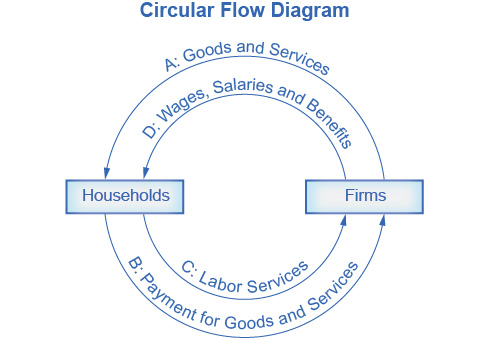2.2 Circular Flow Model
The circular Flow Diagram(Fig 2.1) pictures the economy as consisting of two groups—households and firms—that interact in two markets: the goods and services market, in which firms sell and households buy and the labour market, in which households sell, labour to business firms or other employees. The direction of the arrows shows that in the goods and services market, households receive goods and services and pay firms for them. In the labour market, households provide labour and receive payment from firms through wages, salaries, and benefits.

Firms produce and sell goods and services to households in the market for goods and services (or product market). The arrow “A” indicates this. Households pay for goods and services, which become the revenues to firms. Arrow “B” indicates this. Arrows A and B represent the two sides of the product market. Where do households obtain the income to buy goods and services? They provide the labour and other resources (e.g. land, capital, raw materials) firms need to produce goods and services in the market for inputs (or factors of production). The arrow “C” indicates this. In return, firms pay for the inputs (or resources) they use in the form of wages and other factor payments. The arrow “D” indicates this. Arrows “C” and “D” represent the two sides of the factor market.
There are many different markets for goods and services and different types of labour. The circular flow diagram simplifies this to make the picture easier to grasp. In the diagram, firms produce goods and services, which they sell to households in return for revenues. The outer circle shows this and represents the two sides of the product market (for example, the market for goods and services) in which households demand and firms supply. Households sell their labour as workers to firms in return for wages, salaries, and benefits. The inner circle shows this and represents the two sides of the labour market in which households supply and firms demand.
This version of the circular flow model is stripped down to the essentials, but it has enough features to explain how the product and labour markets work in the economy. We could easily add details to this basic model if we wanted to introduce more real-world elements, like financial markets, governments, and interactions with the rest of the globe (imports and exports).
Attribution
“1.3 How Economists use Theories and Models to Understand Economic Issues” in Principles of Economics 2e by OpenStax is licensed under Creative Commons Attribution 4.0 International License.

